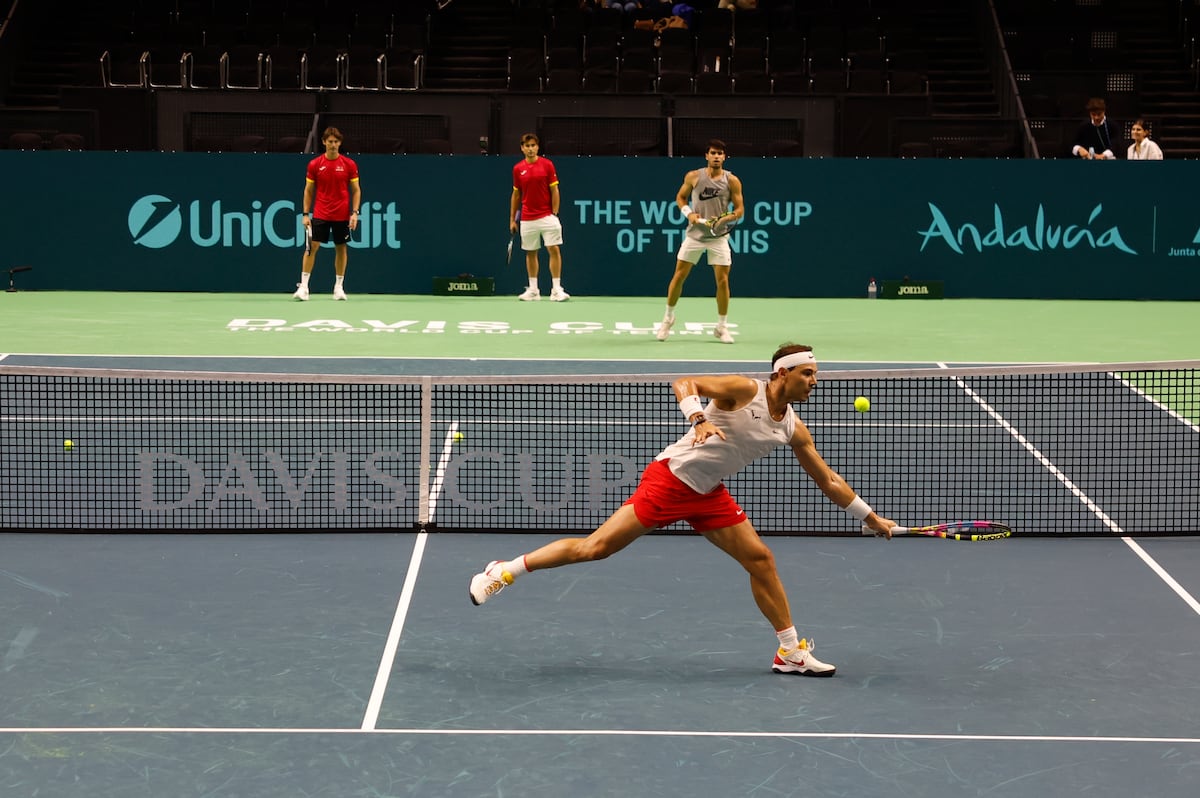In the winter of 2000, Mikel Zabalza flew many meters through the air, so many that he forgot whether he was roped or not. Then the rope attached to his harness tightened and the pain came. His crampons hit the ice, causing a fracture of his tibia and fibula. That same spring, against all logic, he took a flight to Kathmandu (Nepal) and then another to Lhasa (Tibet) with the idea of climbing the north face of Everest. He left the crutches at the airport (they looked like stumps) with which he had trained by climbing on one leg and boarded smiling. Almost a quarter of a century later, Mikel (54 years old) smiles in the same way looking at the scars from his latest fractures: in 2020 he suffered a fall while climbing, split his head open and fractured both wrists. “I have broken many bones. Several times tibia and fibula, head of femur, ribs, ulna, radius, wrists, but I am quite well… it will be because the body regenerates,” he says, sitting in the living room of his house from where the walls of Etxauri can be seen, 15 minutes from Pamplona, one of the most special corners that a climber can admire.
But Mikel does not have a privileged body. He is not a great athlete, nor the strongest climber, nor the fastest, nor the most technical. Sometimes, while walking, he limps slightly and slouches, but you should not be mistaken: with two ice axes in his hands he is a different being. The most passionate one can imagine. His motivation is infinite, unwavering, incomprehensible, even to those around him. He is also the most prolific Spanish mountaineer still active, a man gifted with a privileged multidisciplinary vision whose life is a constant coming and going. “I like being at home,” he says. “But you’re never there,” his partner responds without a hint of reproach.
It is simply a fact. Mikel conceives life in movement, a movement that brings him, like the turning of a dynamo, light and happiness. “Motivation comes from within and for me it has no greater explanation than continuing to do something that brings you joy, which is what we all seek,” he sums up simply. Zabalza has never been able to make a living from mountaineering. “It’s something that my mother also asks herself,” she laughs, before conceding that “perhaps I haven’t known how to sell myself, but the truth is that I haven’t worried much about that aspect either, but rather I’ve worried more about fulfilling my dreams, even if they were my pocket I can say that the only sacrifice I have had to make has been to give up economic stability, something that I am now resolving with my work as a guide.”
There are not many on the entire planet with a curriculum as varied and select as his: from Patagonia to Antarctica passing through the most technical mountains of the Himalayas and ending in his beloved Pyrenees, in all these places he has opened new routes, climbed peaks remote, relentlessly living adventures so demanding that the strange thing is that your brain does not ask for a truce. “Retreat? No, why? He asks surprised. I am stopping directing the Spanish Mountaineering Team after 13 years, but I hope to continue with my expeditions,” he says. At the moment, he is being demanded from all sides: he has been a jury member for the prestigious Piolets de Oro, a jury member for the Alta Montaña Festival in Jaca, he will release his first book in 2025 and he has said goodbye to the national team without making a sound: “The decision to leave the team has been meditated and taken for just over a year. Over the years we lose capabilities, something inherent to the passage of time. Another important reason has been the accident I had in Etxauri four years ago because I have experienced a before and after as a rock climber. Now I am quite recovered, I climb decently, but not at the level I had before and since many of the team’s outings are on rock, I felt limited in that terrain and that encouraged me to pass on the baton.”
Maintaining a frenetic level of activity implies constant risk-taking, an issue that Zabalza has always handled with great composure throughout his 41 expeditions. “The risk is more difficult to assume for those who stay at home, as is the case with my partner, who is also a mountaineer. My son, who does not have as much mountain knowledge, sees everything as the same because he has always seen me leave and return, but you would have to ask him to really know what he feels about it. I do not try to justify the risk I take: I know that risk is something inherent to my activity and is part of the game, and I must accept it. Once in the game and assuming the rules that you have imposed on yourself, you have to play your cards in the best way possible. Within the framework of that invented game that consists of climbing technical routes in alpine style and in remote places, you know that you are adding risk conditions and that it is essential to play your cards well, being clear that renunciation is a possible part of the game. Each one sets the limit for their resignation. Then, there are external conditions that are beyond your control, such as the weather or terrain conditions, but you can know them and play with them as well. Finally, there are variables such as your partner or your own motivation, but the most difficult thing in mountaineering is making the right decisions. Many times, trying to reach a summit or finish a route, you take one more step and are aware that you are entering an area on the limit: maybe one day you take it and another you don’t dare,” he explains.
Sometimes one more step means death. “When a climber kills himself it is almost always his fault: he did not know how to read the information that the natural environment provided him or he did not interpret the weather forecast correctly and an avalanche hit him or he was caught in a storm. Sometimes you know that you have to go under a serac (unstable mass of ice) and that you are going to be exposed to it breaking and falling on you for 20 minutes, but if it happens it is very bad luck. The normal thing is that a human error is made. In our society, risk and uncertainty are frowned upon terms and it is a phobia that is instilled in children…”, he observes.
Mikel Zabalza sees mountaineering as a vital necessity even though he has lost several friends along the way: some died and others stopped going out to the mountains. There was no mountaineering tradition in his family, but when he turned 10 he approached a club in Pamplona and started going out on weekends. “The books further fueled the desire to continue learning about the mountains. Now it makes me sad to see that my students don’t read… but it is difficult to motivate them. Now that I have been to the Alta Montaña Festival in Jaca as a jury, I have seen beautiful creations but I still think that the imagination flies much further with reading. It’s its magic: making a composition in your head,” he reflects.
A few years ago, Jordi Corominas, who also directed the National Mountaineering Team, confirmed that 90% of those who passed through it left high-level mountaineering. “Now it’s not that they stop, but they do reduce the intensity because at the end of their cycle their motivation is not as strong. It depends on your personality: mountaineering is very passionate, it is very hard, you are cold, afraid, you get up very early, it is dangerous, uncomfortable and all of this is tiring in the long run and many give it up or practice it from time to time. But I believe that adventure will always have followers. “I need it.”









